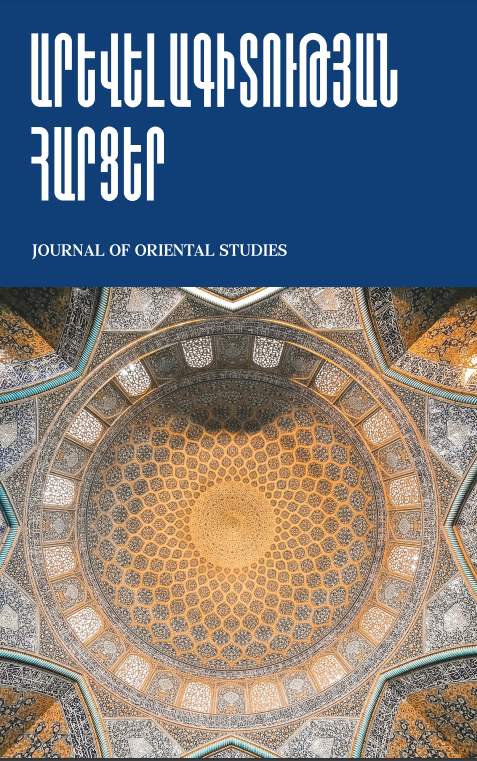XX CENTURY PARIS IN THE LIFE OF AN IRANIAN EXILE WRITER
DOI:
https://doi.org/10.46991/jos.2024.25.1.016Keywords:
Paris , Cultural Studies, City, Fiction, Iran, Diaspora, Exile, Experience, AlienationAbstract
The city is a dynamic system that is constantly in motion. As a historical and cultural phenomenon, the city has found its expression in artistic literature. For centuries, writers from around the world, carrying their native cities within themselves on their paths of exile. They have discovered new cities that have become harbingers of joy and sorrow in their destinies. The literary image of Paris appeared in American and Russian literature in the 1920s and 1930s. In their works, exiled writers depicted the city's national character, urban environment, lifestyle, as well as the 'spirit' of the city. In the literary reflections of Iranian exile writers, Paris loses its artistic quality and emerges as a geographical record of the pain and alienation experienced by immigrants in the diaspora.
References
Анциферов Н. П., Проблемы урбанизма в русской художественной литературе: опыт построения идеи города Петербурга у Достоевского на основе анализа литературных традиций., Москва ИМЛИ РАН, 2009.
Беспалова Е. К., Париж глазами эмигрантов,- Мировая литература на перекрестье культур и цивилизаций, № 1–2 , 2017, ст. 17-31.
Биск А., Русский Париж 1906-1908 гг. Воспоминания о Серебряном веке, М., 1993․
Бунин И., Темные аллеи. Собрание сочинений в 9-ти т. Т. 7. М.: Художественная литература,1966.
Набилкина Л․ Н․, Образ города в мировой литературе,- Теория и практика общественного развития, № 3, 2014, ст.219-222.
Щукин В. Г. Поэтика города. Морфология поэтосферы,- Альманах теории и истории науки, № 7. 2013, ст. 299-336.
Baraheni R., Exilic Blindness: The Unwritten Autobiography of a Dramatist in Paris Posthumously Dictated to a Friend. -Modern Drama, Volume 46, Number 1, Spring 2003, pp.113-118.
Calvino I., Invisible Cities, Boston: Mariner Books, Classics, 1978.
Dabashi H., Corpus Anarchicum: Political Protest, Suicidal Violence and the Making of Posthuman Body, London: Palgrave Macmillan, 2012, eBook.
Farrokh F., Yavari H., Sa'edi, Gholam- Hosayn. - Encyclopedia Iranica, 19 May, 2016 http://www.iranicaonline.org/articles/saedi-gholam-hosayn
Giddens A. - Modernity and Self Identity. Self and Society in Late Modern Age, Stanford: Stanford University Press, 1991.
Guppy Sh., A Girl in Paris: A Persian Encounter with the West, New York: Tauris Parke Paperbacks, 2008,
Katouzian H., Sadegh Hedayat: The Life and the Legend of an Iranian Writer, London, New York: I. B. Tauris & Co, 2002.
Naficy H., The Making of Exile Cultures: Iranian Television in Los Angeles, Univ. of Minnesota Press, 1993.
Rahimieh N., Hedayat's translation of Kafka and the logic of Iranian modernity. - Katouzian H., Sadegh Hedayat: His Work and His Wondrous World, New York: Routledge, 2008,
Rushdie S., Imaginary Homelands: Essays and Criticism 1981-1991, London: Granta Books,1991.
Saedi Gholam Hosayn, Avatars in Exile, trans Pakravan S., - Chanteh, Spring: 35, 1993.
Downloads
Published
How to Cite
Issue
Section
License
Copyright (c) 2024 Lilit Safrastyan

This work is licensed under a Creative Commons Attribution-NonCommercial 4.0 International License.
Authors will be entitled in ownership of the copyright for their publications.
Permitted third party reuse is defined by the following user license:
Creative Commons Attribution-Non-Commercial (CC BY-NC). CC BY-NC allows users to
copy and distribute the article, provided this is not done for commercial purposes. The users may
adapt – remix, transform, and build upon the material giving appropriate credit, providing a link
to the license. The full details of the license are available
at https://creativecommons.org/licenses/by-nc/4.0/.
Under this license, authors retain ownership of the copyright for their publications, but
grant Journal of Օriental Studies and Yerevan State University
Publishing house a non-exclusive license to publish the work in paper and electronic form and
allow anyone to reuse, distribute and reproduce the content as long as the original work is
properly cited. Appropriate attribution can be provided by simply citing the original work. No
permission is required from the authors or the publishers.

